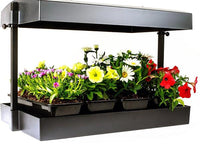The exact amount of light vs darkness your grow needs depends on a few factors:
- The particular strains you’re growing
- Growing stage (vegetation, flowering)
- Grow light type (LED, fluorescent, HID)
- Distance between plants & light source
Some of these factors may not make a big difference.
Below are general “rules of thumb” for indoor light cycles. Obvious exceptions are autoflowering strains. These strains are bred so that flowering begins after a fixed period of time regardless of light/dark cycles.
Vegetative Stage Lighting Requirements
During the vegetative stage, your plants will need to get at least 13 hours of light daily. Otherwise, they might start flowering too early.
A lot of indoor growers give their plants 18 or 24 hours of light every day until it’s time to let them flower. This encourages faster growth and stronger branches that can handle high yields.
Some growers don’t want to overwork the plants. Photosynthesis is hard work. Plants have to turn light into sugars and other compounds that create buds and flowers. Darkness gives them permission to break down the energy sources.
13-16 hours of light is usually enough to keep them in the vegetative stage and let them rest without breaking down too much sugar. That sugar will turn into buds.
Some strains may need more than 13-16 hours. Some do best when they get 18 hours, and others might even prefer a full 24 hours of light.
Flowering Stage Lighting Requirements
During the flowering stage, your plants need at least 12 hours of darkness so they can metabolize enough sugars to create buds. If they get 13 or more hours of light, they will likely revert back to the vegetative stage.
Most indoor growers stick to a 12 hours light 12 hours darkness schedule during flowering.
Autoflower Lighting Requirements
Normally, you want to treat autoflowering strains as if they’re in the vegetative stage all the time. They will form buds when they feel like it. That will most likely happen in two or three months, depending on the strain.
If you’re unsure how much light these plants need, you probably can’t go wrong with 18 hours of light daily. Research the strain if you really want to dial it in.
Do Your Homework for Each Strain
Indoor growers should always look at the specs for each strain as well as suggested lighting schedules. Different strains have different needs. Some also might have specific hacks growers can use to maximize yield and bud quality.
Also keep in mind that different strains may have different preferred lengths of time that they like to spend vegetating and flowering. Do your homework for each strain to find the best time for switching from a vegetative to a flowering light schedule.
Turning Lights On/Off Manually vs Using Timers
If you have one grow room/tent, then the plants are probably on one growing schedule. It’s probably not hard to turn some lights on or off a couple times per day.
If you have more than one grow, each of which is on a different growing schedule, that makes things more complicated.
Either way, you have to keep track of everything and stick to a strict schedule.
Do you sleep less than six hours per night? If not, you may need timers to keep your grow on an 18/6 schedule.
Some light systems have their own timers. The California Lightworks SolarSystem® Series lets you change not only whether the LEDs are on or off. It also lets you control the color spectrum and other settings.
What Type of Growing Timer Do You Need?
There are those who try to save money and rig up a power strip with an analogue timer system. Analogue timers will at least know to turn a light on or off. Make sure you know how much power they can handle.
Digital timers can be programmed to run on different schedules each day. They are very precise, right down to the minute or second. You can use them for fans, watering systems, and other things you need for your grow.
The LTL Controls Stage 2 Advanced Multifunctional Recycling Timer has four outlets. That means it’s two timers in one. Each set of two power outlets is one timer. When one outlet is on, the other is off. The device also lets you give it instructions so it knows what to do during power outages.
The LTL Controls Stage 2 is a good all around timer we carry at Grow Supply Shop.
Another is the LTL Stage 3 Combination Recycling and Lighting Timer.
This one has safety features designed specifically for HID lighting. It can handle up to two 600W lights. HID lights can get hot. One of the safety features is a temperature sensor that turns the lights off when they get too hot.
Whatever timer you buy, make sure it can handle your lights and/or other devices. Some will burn out more easily than others and ruin your grow if you’re not paying attention. You don’t want to start a fire either.
If you want to power up to 16 lights and have more control over amperage and other safety metrics, you can invest in the LTL Master 16 Lighting Controller. It can even control two separate grow rooms, each with eight lights and its own lighting schedule. Lots of flexibility there.













